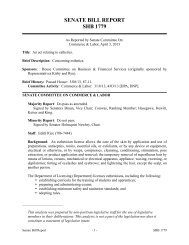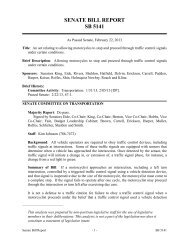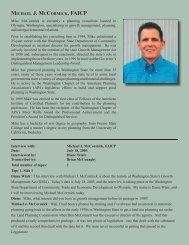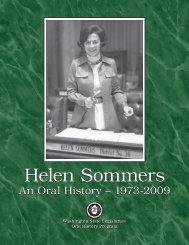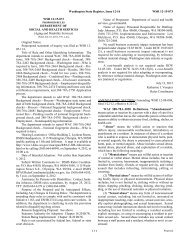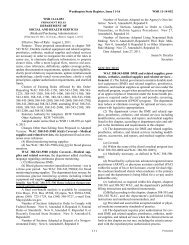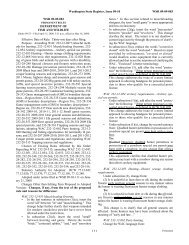Proposed
Proposed
Proposed
You also want an ePaper? Increase the reach of your titles
YUMPU automatically turns print PDFs into web optimized ePapers that Google loves.
(c) "Service-entrance conductors, underground system"<br />
means the service conductors between the terminals of the<br />
service equipment and the point of connection to the service<br />
lateral or service point. Where the service equipment is<br />
located outside the building walls, there may be no serviceentrance<br />
conductors or they may be entirely outside the<br />
building.<br />
(d) "Service lateral" means the underground service conductors<br />
from the service point to the point of connection to<br />
the service-entrance conductors in a terminal box, meter, or<br />
other enclosure. Where there is not a terminal box, meter, or<br />
other enclosure, the point of connection is the point of<br />
entrance of the service conductors into the building.<br />
(((61))) A "stand-alone amplified sound or public<br />
address system" is a system that has distinct wiring and<br />
equipment for audio signal generation, recording, processing,<br />
amplification, and reproduction. This definition does not<br />
apply to telecommunications installations.<br />
(((62))) "Service" or "served" means that as defined in<br />
RCW 34.05.010(19) when used in relation to department<br />
actions or proceedings.<br />
(((63))) A "sign," when required by the NEC, for use as<br />
an identification method (e.g., legibly marked, legible warning<br />
notice, marked, field marked, permanent plaque/directory,<br />
etc.) means "identification plate."<br />
(((64))) "Story" is that portion of a building included<br />
between the upper surface of a floor and the upper surface of<br />
the floor or roof next above. Next above means vertically and<br />
not necessarily directly above. Also see "basement" and<br />
"mezzanine."<br />
(((65))) "Structure," for the purposes of this chapter and<br />
in addition to the definition in the NEC, means something<br />
constructed either in the field or factory that is used or<br />
intended for supporting or sheltering any use or occupancy as<br />
defined by the IBC.<br />
(((66))) "Supervision" for the purpose of supervising<br />
electrical trainees, means that the appropriately certified<br />
supervising electrician is on the same job site as the trainee<br />
being supervised. The trainee is not considered to be on the<br />
same job site if the supervising electrician and the trainee are<br />
working:<br />
(a) In separate buildings at a single address (e.g., a campus,<br />
multibuilding industrial complex, multibuilding apartment<br />
complex, etc.) except for a single-family residence; or<br />
(b) On an outdoor project (e.g., irrigation system, farm,<br />
street lighting, traffic signalization, etc.) where the trainee is<br />
more than one thousand feet from the supervising electrician<br />
or where the trainee is more than two hundred feet from the<br />
supervising electrician and out of sight.<br />
"System design review" means a set of design documents<br />
that include the manufacturer's installation information,<br />
a legible one-line diagram of the system design, and calculations<br />
used to determine voltage and current within the<br />
system. The one-line diagram must show the system equipment,<br />
devices, overcurrent protection, conductor sizing,<br />
grounding, ground fault protection if required, and any system<br />
interconnection points. The review must be available to<br />
the inspector during all inspections.<br />
"Telecommunications" means any transmission, emission,<br />
and reception of data over radio frequency, wire, or<br />
Washington State Register, Issue 12-21 WSR 12-21-103<br />
optical fiber from a transmitter(s) to a receiver(s). The mode<br />
of modulation may be either analog or digital. Telecommunications<br />
is not the transmission of any level of electrical<br />
power that is used to provide operational power (e.g., relay<br />
operation, motor function, lighting power, switching power,<br />
device power, etc.). If a circuit contains both operational<br />
power and telecommunications, the circuit is not telecommunications.<br />
A "telecommunications local service provider" is a regulated<br />
or unregulated (e.g., by the Federal Communications<br />
Commission or the utilities and transportation commission as<br />
a telephone or telecommunications provider) firm providing<br />
telecommunications service ahead of the telecommunications<br />
network demarcation point to an end-user's facilities.<br />
(((67))) "TIA/EIA" means the Telecommunications<br />
Industries Association/Electronic Industries Association<br />
which publishes the TIA/EIA Telecommunications Building<br />
Wiring Standards. Standards and publications are adopted by<br />
TIA/EIA in accordance with the American National Standards<br />
Institute (ANSI) patent policy.<br />
(((68))) A "training school" is a public community or<br />
technical college or not-for-profit nationally accredited technical<br />
or trade school licensed by the work force training and<br />
education coordinating board under chapter 28C.10 RCW.<br />
(((69))) "Under the control of a utility" for the purposes<br />
of RCW 19.28.091 and 19.28.101 is when electrical equipment<br />
is not owned by a utility and:<br />
(a) Is located in a vault, room, closet, or similar enclosure<br />
that is secured by a lock or seal so that access is<br />
restricted to the utility's personnel; or<br />
(b) The utility is obligated by contract to maintain the<br />
equipment and the contract provides that access to the equipment<br />
is restricted to the utility's personnel or other qualified<br />
personnel.<br />
(((70))) "UL" means Underwriters Laboratory.<br />
(((71))) "Utility" means an electrical utility.<br />
(((72))) "Utility system" means electrical equipment<br />
owned by or under the control of a serving utility that is used<br />
for the transmission or distribution of electricity from the<br />
source of supply to the point of contact and is defined in section<br />
90.2 (b)(5) of the National Electrical Code, 1981 edition<br />
(see RCW 19.28.010(1)).<br />
(((73))) "Utilization voltage" means the voltage level<br />
employed by the utility's customer for connection to lighting<br />
fixtures, motors, heaters, or other electrically operated equipment<br />
other than power transformers.<br />
(((74))) "Variance" is a modification of the electrical<br />
requirements as adopted in chapter 19.28 RCW or any other<br />
requirements of this chapter that may be approved by the<br />
chief electrical inspector if assured that equivalent objectives<br />
can be achieved by establishing and maintaining effective<br />
safety.<br />
(((75))) "WAC" means the Washington Administrative<br />
Code. Copies of this chapter of the WAC((s)) are available<br />
from the department and the office of the code reviser.<br />
[ 35 ] <strong>Proposed</strong>



